RGB color model

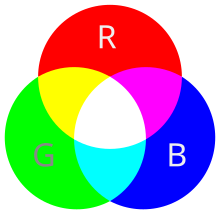
The RGB color model (UK spelling: RGB colour model) is an
The main purpose of the RGB color model is for the sensing, representation, and display of images in electronic systems, such as televisions and computers, though it has also been used in conventional
RGB is a device-dependent color model: different devices detect or reproduce a given RGB value differently, since the color elements (such as phosphors or dyes) and their response to the individual red, green, and blue levels vary from manufacturer to manufacturer, or even in the same device over time. Thus an RGB value does not define the same color across devices without some kind of color management.[3][4]
Typical RGB
Additive colors
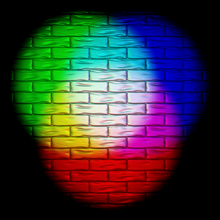
To form a color with RGB, three light beams (one red, one green, and one blue) must be superimposed (for example by emission from a black screen or by reflection from a white screen). Each of the three beams is called a component of that color, and each of them can have an arbitrary intensity, from fully off to fully on, in the mixture.
The RGB color model is additive in the sense that if light beams of differing color (frequency) are superposed in space their light spectra adds up, wavelength for wavelength, to make up a resulting, total spectrum.
Zero intensity for each component gives the darkest color (no light, considered the black), and full intensity of each gives a
When one of the components has the strongest intensity, the color is a hue near this primary color (red-ish, green-ish, or blue-ish), and when two components have the same strongest intensity, then the color is a hue of a secondary color (a shade of cyan, magenta or yellow). A secondary color is formed by the sum of two primary colors of equal intensity: cyan is green+blue, magenta is blue+red, and yellow is red+green. Every secondary color is the complement of one primary color: cyan complements red, magenta complements green, and yellow complements blue. When all the primary colors are mixed in equal intensities, the result is white.
The RGB
Physical principles for the choice of red, green, and blue
The choice of primary colors is related to the physiology of the human eye; good primaries are stimuli that maximize the difference between the responses of the cone cells of the human retina to light of different wavelengths, and that thereby make a large color triangle.[7]
The normal three kinds of light-sensitive photoreceptor cells in the human eye (cone cells) respond most to yellow (long wavelength or L), green (medium or M), and violet (short or S) light (peak wavelengths near 570 nm, 540 nm and 440 nm, respectively[7]). The difference in the signals received from the three kinds allows the brain to differentiate a wide gamut of different colors, while being most sensitive (overall) to yellowish-green light and to differences between hues in the green-to-orange region.
As an example, suppose that light in the orange range of wavelengths (approximately 577 nm to 597 nm) enters the eye and strikes the retina. Light of these wavelengths would activate both the medium and long wavelength cones of the retina, but not equally—the long-wavelength cells will respond more. The difference in the response can be detected by the brain, and this difference is the basis of our perception of orange. Thus, the orange appearance of an object results from light from the object entering our eye and stimulating the different cones simultaneously but to different degrees.
Use of the three primary colors is not sufficient to reproduce all colors; only colors within the color triangle defined by the chromaticities of the primaries can be reproduced by additive mixing of non-negative amounts of those colors of light.[7][page needed]
History of RGB color model theory and usage
The RGB color model is based on the Young–Helmholtz theory of trichromatic color vision, developed by Thomas Young and Hermann von Helmholtz in the early to mid-nineteenth century, and on James Clerk Maxwell's color triangle that elaborated that theory (c. 1860).
Photography
The first experiments with RGB in early color photography were made in 1861 by Maxwell himself, and involved the process of combining three color-filtered separate takes.[1] To reproduce the color photograph, three matching projections over a screen in a dark room were necessary.
The additive RGB model and variants such as orange–green–violet were also used in the
When employed, the reproduction of prints from three-plate photos was done by dyes or pigments using the complementary CMY model, by simply using the negative plates of the filtered takes: reverse red gives the cyan plate, and so on.
Television
Before the development of practical electronic TV, there were patents on mechanically scanned color systems as early as 1889 in Russia. The color TV pioneer John Logie Baird demonstrated the world's first RGB color transmission in 1928, and also the world's first color broadcast in 1938, in London. In his experiments, scanning and display were done mechanically by spinning colorized wheels.[10][11]
The
More recently, color wheels have been used in field-sequential projection TV receivers based on the Texas Instruments monochrome DLP imager.The modern RGB shadow mask technology for color CRT displays was patented by Werner Flechsig in Germany in 1938.[15]
Personal computers
RGB devices
RGB and displays
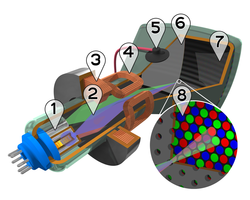

One common application of the RGB color model is the display of colors on a cathode-ray tube (CRT), liquid-crystal display (LCD), plasma display, or organic light emitting diode (OLED) display such as a television, a computer's monitor, or a large scale screen. Each pixel on the screen is built by driving three small and very close but still separated RGB light sources. At common viewing distance, the separate sources are indistinguishable, which the eye interprets as a given solid color. All the pixels together arranged in the rectangular screen surface conforms the color image.
During
The Quattron released by Sharp uses RGB color and adds yellow as a sub-pixel, supposedly allowing an increase in the number of available colors.
Video electronics
RGB is also the term referring to a type of
Outside Europe, RGB is not very popular as a video signal format; S-Video takes that spot in most non-European regions. However, almost all computer monitors around the world use RGB.
Video framebuffer
A
A CLUT is a specialized
- RGB24 and RGB32
This indirect scheme restricts the number of available colors in an image CLUT—typically 256-cubed (8 bits in three
Modern storage, however, is far less costly, greatly reducing the need to minimize image file size. By using an appropriate combination of red, green, and blue intensities, many colors can be displayed. Current typical
For images with a modest range of brightnesses from the darkest to the lightest, eight bits per primary color provides good-quality images, but extreme images require more bits per primary color as well as the advanced display technology. For more information see
Nonlinearity
In classic CRT devices, the brightness of a given point over the fluorescent screen due to the impact of accelerated electrons is not proportional to the voltages applied to the electron gun control grids, but to an expansive function of that voltage. The amount of this deviation is known as its gamma value (), the argument for a power law function, which closely describes this behavior. A linear response is given by a gamma value of 1.0, but actual CRT nonlinearities have a gamma value around 2.0 to 2.5.
Similarly, the intensity of the output on TV and computer display devices is not directly proportional to the R, G, and B applied electric signals (or file data values which drive them through digital-to-analog converters). On a typical standard 2.2-gamma CRT display, an input intensity RGB value of (0.5, 0.5, 0.5) only outputs about 22% of full brightness (1.0, 1.0, 1.0), instead of 50%.[19] To obtain the correct response, a gamma correction is used in encoding the image data, and possibly further corrections as part of the color calibration process of the device. Gamma affects black-and-white TV as well as color. In standard color TV, broadcast signals are gamma corrected.
RGB and cameras
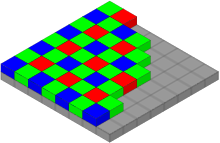
In color television and video cameras manufactured before the 1990s, the incoming light was separated by prisms and filters into the three RGB primary colors feeding each color into a separate video camera tube (or pickup tube). These tubes are a type of cathode-ray tube, not to be confused with that of CRT displays.
With the arrival of commercially viable charge-coupled device (CCD) technology in the 1980s, first, the pickup tubes were replaced with this kind of sensor. Later, higher scale integration electronics was applied (mainly by Sony), simplifying and even removing the intermediate optics, thereby reducing the size of home video cameras and eventually leading to the development of full camcorders. Current webcams and mobile phones with cameras are the most miniaturized commercial forms of such technology.
Photographic digital cameras that use a CMOS or CCD image sensor often operate with some variation of the RGB model. In a Bayer filter arrangement, green is given twice as many detectors as red and blue (ratio 1:2:1) in order to achieve higher luminance resolution than chrominance resolution. The sensor has a grid of red, green, and blue detectors arranged so that the first row is RGRGRGRG, the next is GBGBGBGB, and that sequence is repeated in subsequent rows. For every channel, missing pixels are obtained by interpolation in the demosaicing process to build up the complete image. Also, other processes used to be applied in order to map the camera RGB measurements into a standard RGB color space as sRGB.
RGB and scanners
In computing, an
Currently available scanners typically use CCD or
Numeric representations
| #FFCCCC | #FFC0C0 | #FF9999 | #FF8080 | #FF6666 | #FF4040 | #FF3333 | #FF0000 |
| #FFE5CC | #FFE0C0 | #FFCC99 | #FFC080 | #FFB266 | #FFA040 | #FF9933 | #FF8000 |
| #FFFFCC | #FFFFC0 | #FFFF99 | #FFFF80 | #FFFF66 | #FFFF40 | #FFFF33 | #FFFF00 |
| #FFFFE5 | #FFFFE0 | #FFFFCC | #FFFFC0 | #FFFFB2 | #FFFFA0 | #FFFF99 | #FFFF80 |
| #E5FFCC | #E0FFC0 | #CCFF99 | #C0FFA0 | #B2FF66 | #A0FF40 | #99FF33 | #80FF00 |
| #CCFFCC | #C0FFC0 | #99FF99 | #80FF80 | #66FF66 | #40FF40 | #33FF33 | #00FF00 |
| #E5FFE5 | #E0FFE0 | #CCFFCC | #C0FFC0 | #B2FFB2 | #A0FFA0 | #99FF99 | #80FF80 |
| #CCE5CC | #C0E0C0 | #99CC99 | #80C080 | #66B266 | #40A040 | #339933 | #008000 |
| #CCFFE5 | #C0FFE0 | #99FFCC | #80FFC0 | #66FFB2 | #40FFA0 | #33FF99 | #00FF80 |
| #CCFFFF | #C0FFFF | #99FFFF | #80FFFF | #66FFFF | #40FFFF | #33FFFF | #00FFFF |
| #E5FFFF | #E0FFFF | #CCFFFF | #C0FFFF | #B2FFFF | #A0FFFF | #99FFFF | #80FFFF |
| #CCE5E5 | #C0E0E0 | #99CCCC | #80C0C0 | #66B2B2 | #40A0A0 | #339999 | #008080 |
| #CCE5FF | #C0E0FF | #99CCFF | #80C0FF | #66B2FF | #40A0FF | #3399FF | #0080FF |
| #CCCCFF | #C0C0FF | #9999FF | #8080FF | #6666FF | #4040FF | #3333FF | #0000FF |
| #CCCCE5 | #C0C0E0 | #9999CC | #8080C0 | #6666B2 | #4040A0 | #333399 | #000080 |
| #E5E5FF | #E0E0FF | #CCCCFF | #C0C0FF | #B2B2FF | #A0A0FF | #9999FF | #8080FF |
| #E5CCFF | #E0C0FF | #CC99FF | #C080FF | #B266FF | #A040FF | #9933FF | #8000FF |
| #E5CCE5 | #E0C0E0 | #CC99CC | #C080C0 | #B266B2 | #A040A0 | #993399 | #800080 |
| #FFCCFF | #FFC0FF | #FF99FF | #FF80FF | #FF66FF | #FF40FF | #FF33FF | #FF00FF |
| #FFE5FF | #FFE0FF | #FFCCFF | #FFC0FF | #FFB2FF | #FFA0FF | #FF99FF | #FF80FF |
| #FFCCE5 | #FFC0E0 | #FF99CC | #FF80C0 | #FF66B2 | #FF40A0 | #FF3399 | #FF0080 |
| #FFE5E5 | #FFE0E0 | #FFCCCC | #FFC0C0 | #FFB2B2 | #FFA0A0 | #FF9999 | #FF8080 |
| #E5CCCC | #E0C0C0 | #CC9999 | #C08080 | #B26666 | #A04040 | #993333 | #800000 |
| #E5E5CC | #E0E0C0 | #CCCC99 | #C0C080 | #B2B266 | #A0A040 | #999933 | #808000 |
| #E5E5E5 | #E0E0E0 | #CCCCCC | #C0C0C0 | #B2B2B2 | #A0A0A0 | #999999 | #808080 |
| #FF0000 | #CC0000 | #C00000 | #990000 | #800000 | #660000 | #400000 | #330000 |
| #FF8000 | #CC6600 | #C06000 | #994C00 | #804000 | #663300 | #402000 | #331900 |
| #FFFF00 | #CCCC00 | #C0C000 | #999900 | #808000 | #666600 | #404000 | #333300 |
| #FFFF80 | #CCCC66 | #C0C060 | #99994C | #808040 | #666633 | #404020 | #333319 |
| #80FF00 | #66CC00 | #60C000 | #4C9900 | #408000 | #336600 | #204000 | #193300 |
| #00FF00 | #00CC00 | #00C000 | #009900 | #008000 | #006600 | #004000 | #003300 |
| #80FF80 | #66CC66 | #60C060 | #4C994C | #408040 | #336633 | #204020 | #193319 |
| #008000 | #006600 | #006000 | #004C00 | #004000 | #003300 | #002000 | #001900 |
| #00FF80 | #00CC66 | #00C060 | #00994C | #008040 | #006633 | #004020 | #003319 |
| #00FFFF | #00CCCC | #00C0C0 | #009999 | #008080 | #006666 | #004040 | #003333 |
| #80FFFF | #66CCCC | #60C0C0 | #4C9999 | #408080 | #336666 | #204040 | #193333 |
| #008080 | #006666 | #006060 | #004C4C | #004040 | #003333 | #002020 | #001919 |
| #0080FF | #0066CC | #0060C0 | #004C99 | #004080 | #003366 | #002040 | #001933 |
| #0000FF | #0000CC | #0000C0 | #000099 | #000080 | #000066 | #000040 | #000033 |
| #000080 | #000066 | #000060 | #00004C | #000040 | #000033 | #000020 | #000019 |
| #8080FF | #6666CC | #6060C0 | #4C4C99 | #404080 | #333366 | #202040 | #191933 |
| #8000FF | #6600CC | #6000C0 | #4C0099 | #400080 | #330066 | #200040 | #190033 |
| #800080 | #660066 | #600060 | #4C004C | #400040 | #330033 | #200020 | #190019 |
| #FF00FF | #CC00CC | #C000C0 | #990099 | #800080 | #660066 | #400040 | #330033 |
| #FF80FF | #CC66CC | #C060C0 | #994C99 | #804080 | #663366 | #402040 | #331933 |
| #FF0080 | #CC0066 | #C00060 | #99004C | #800040 | #660033 | #400020 | #330019 |
| #FF8080 | #CC6666 | #C06060 | #994C4C | #804040 | #663333 | #402020 | #331919 |
| #800000 | #660000 | #600000 | #4C0000 | #400000 | #330000 | #200000 | #190000 |
| #808000 | #666600 | #606000 | #4C4C00 | #404000 | #333300 | #202000 | #191900 |
| #808080 | #666666 | #606060 | #4C4C4C | #404040 | #333333 | #202020 | #191919 |


A color in the RGB color model is described by indicating how much of each of the red, green, and blue is included. The color is expressed as an RGB triplet (r,g,b), each component of which can vary from zero to a defined maximum value. If all the components are at zero the result is black; if all are at maximum, the result is the brightest representable white.
These ranges may be quantified in several different ways:
- From 0 to 1, with any fractional value in between. This representation is used in theoretical analyses, and in systems that use floating pointrepresentations.
- Each color component value can also be written as a percentage, from 0% to 100%.
- In computers, the component values are often stored as unsigned integer numbers in the range 0 to 255, the range that a single 8-bit byte can offer. These are often represented as either decimal or hexadecimal numbers.
- High-end digital image equipment are often able to deal with larger integer ranges for each primary color, such as 0..1023 (10 bits), 0..65535 (16 bits) or even larger, by extending the 24-bits (three 8-bit values) to 32-bit, 48-bit, or 64-bit units (more or less independent from the particular computer's word size).
For example, brightest saturated red is written in the different RGB notations as:
Notation RGB triplet Arithmetic (1.0, 0.0, 0.0) Percentage (100%, 0%, 0%) Digital 8-bit per channel (255, 0, 0)
#FF0000 (hexadecimal)Digital 12-bit per channel (4095, 0, 0)
#FFF000000Digital 16-bit per channel (65535, 0, 0)
#FFFF00000000Digital 24-bit per channel (16777215, 0, 0)
#FFFFFF000000000000Digital 32-bit per channel (4294967295, 0, 0)
#FFFFFFFF0000000000000000
In many environments, the component values within the ranges are not managed as linear (that is, the numbers are nonlinearly related to the intensities that they represent), as in digital cameras and TV broadcasting and receiving due to gamma correction, for example.[20] Linear and nonlinear transformations are often dealt with via digital image processing. Representations with only 8 bits per component are considered sufficient if gamma correction is used.[21]
Following is the mathematical relationship between RGB space to HSI space (hue, saturation, and intensity:
If , then .
Color depth
The RGB color model is one of the most common ways to encode color in computing, and several different digital representations are in use. The main characteristic of all of them is the quantization of the possible values per component (technically a sample ) by using only integer numbers within some range, usually from 0 to some power of two minus one (2n − 1) to fit them into some bit groupings. Encodings of 1, 2, 4, 5, 8 and 16 bits per color are commonly found; the total number of bits used for an RGB color is typically called the color depth.
Geometric representation
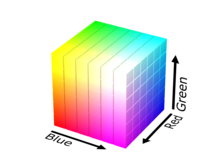
Since colors are usually defined by three components, not only in the RGB model, but also in other color models such as
An RGB triplet (r,g,b) represents the three-dimensional coordinate of the point of the given color within the cube or its faces or along its edges. This approach allows computations of the color similarity of two given RGB colors by simply calculating the distance between them: the shorter the distance, the higher the similarity. Out-of-gamut computations can also be performed this way.
Colors in web-page design
Initially, the limited color depth of most video hardware led to a limited color palette of 216 RGB colors, defined by the Netscape Color Cube. The
With the predominance of 24-bit displays, the use of the full 16.7 million colors of the HTML RGB color code no longer poses problems for most viewers. The sRGB color space (a device-independent color space[23]) for HTML was formally adopted as an Internet standard in HTML 3.2,[24][25] though it had been in use for some time before that. All images and colors are interpreted as being sRGB (unless another color space is specified) and all modern displays can display this color space (with color management being built in into browsers[26][27] or operating systems[28]).
The syntax in CSS is:
rgb(#,#,#)
where # equals the proportion of red, green, and blue respectively. This syntax can be used after such selectors as "background-color:" or (for text) "color:".
Wide gamut color is possible in modern CSS,[29] being supported by all major browsers since 2023.[30][31][32]
For example, a color on the DCI-P3 color space can be indicated as :
color(display-p3 # # #)
where # equals the proportion of red, green, and blue in 0.0 to 1.0 respectively.
Color management
Proper reproduction of colors, especially in professional environments, requires color management of all the devices involved in the production process, many of them using RGB. Color management results in several transparent conversions between device-independent (
RGB model and luminance–chrominance formats relationship
All
Similarly, current high-efficiency digital color image
See also
- CMY color model
- CMYK color model
- Color theory
- Colour banding
- Complementary colors
- DCI-P3 – a common RGB color space
- List of color palettes
- ProPhoto RGB color space
- RG color models
- RGBA color model
- scRGB
- TSL color space
References
- ^ ISBN 1-85669-420-8.
- .
The first of the resolutions offered to the 1931 meeting defined the color-matching functions of the soon-to-be-adopted standard observer in terms of Guild's spectral primaries centered on wavelengths 435.8, 546.1, and 700nm. Guild approached the problem from the viewpoint of a standardization engineer. In his mind, the adopted primaries had to be producible with national-standardizing-laboratory accuracy. The first two wavelengths were mercury excitation lines, and the last named wavelength occurred at a location in the human vision system where the hue of spectral lights was unchanging with wavelength. Slight inaccuracy in production of the wavelength of this spectral primary in a visual colorimeter, it was reasoned, would introduce no error at all.
- ^ GrantMeStrength (30 December 2021). "Device-Dependent Color Spaces - Win32 apps". learn.microsoft.com. Retrieved 2022-10-24.
- ^ Crean, Buckley. "Device Independent Color—Who Wants It?" (PDF). SPIE. 2171: 267.
- ISBN 1-55860-792-7.
- ISBN 1-55622-354-4.
- ^ ISBN 0-470-02425-9.
- ^ Photographer to the Tsar: Sergei Mikhailovich Prokudin-Gorskii Library of Congress.
- ^ "The Evolution of Color Pigment Printing". Artfacts.org. Retrieved 2013-04-29.
- ^ John Logie Baird, Television Apparatus and the Like, U.S. patent, filed in U.K. in 1928.
- ^ Baird Television: Crystal Palace Television Studios. Previous color television demonstrations in the U.K. and U.S. had been via closed circuit.
- ^ "Color Television Success in Test". NY Times. 1940-08-30. p. 21. Retrieved 2008-05-12.
- ^ "CBS Demonstrates Full Color Television," Wall Street Journal, Sept. 5, 1940, p. 1.
- ^ "Television Hearing Set". NY Times. 1940-11-13. p. 26. Retrieved 2008-05-12.
- ISBN 0-7803-9936-6. Archived from the original(PDF) on March 6, 2009.
- ISBN 0580298604.
- ^ "Composite video vs composite sync and Demystifying RGB video". www.retrogamingcables.co.uk. Retrieved 2022-10-24.
- ^ By directory search
- ISBN 0-240-80760-X.
- ISBN 0-240-51908-6.
- ISBN 978-0-240-52005-6.
- ^ For a side-by-side comparison of proper colors next to their equivalent lacking proper gamma correction, see Doucette, Matthew (15 March 2006). "Color List". Xona Games.
- ^ a b "Device-Independent Color Spaces - MATLAB & Simulink". www.mathworks.com.
- ^ "HTML 3.2 Reference Specification". 14 January 1997.
- ^ "A Standard Default Color Space for the Internet - sRGB". W3C.
- ^ "Color management in Internet". www.color-management-guide.com.
- ^ "How to setup proper color management in your web browser - Greg Benz Photography". gregbenzphotography.com. April 27, 2021.
- ^ "About Color Management". support.microsoft.com.
- ^ "Wide Gamut Color in CSS with Display-P3". March 2, 2020.
- ^ ""color" Can I use... Support tables for HTML5, CSS3, etc". Can I use...
- ^ "Wide Gamut Color in CSS with Display-P3". March 2, 2020.
- ^ "CSS color() function". Can I use...
- ^ ICC. "Why Color Management?" (PDF). Retrieved 2008-04-16.
The two PCS's in the ICC system are CIE-XYZ and CIELAB




